Two-way Avid Media Composer Integration
Reading time ~10 minutes
You can import Cinegy objects to Avid Media Composer in three ways:
-
directly from Cinegy Archive Browser (pull from Cinegy Archive);
-
via the post folder in Cinegy Archive Browser;
-
by Cinegy Convert Plugin of the Cinegy desktop (push model).
Import from Cinegy Archive Browser
You can import clips, Rolls, ClipBins and Sequences from Cinegy Archive Browser directly to Avid Media Composer project via simple drag-and-drop. To do so, follow the steps below:
-
Open Avid Media Composer and create a new project.
-
Open Cinegy Archive Browser and select a clip, Roll, ClipBin or Sequence you need to import to Avid Media Composer.
NoteMake sure that the selected media footage has the same format as Avid Media Composer project. -
Drag-and-drop the selected media footage into the Avid Media Composer project bin window.
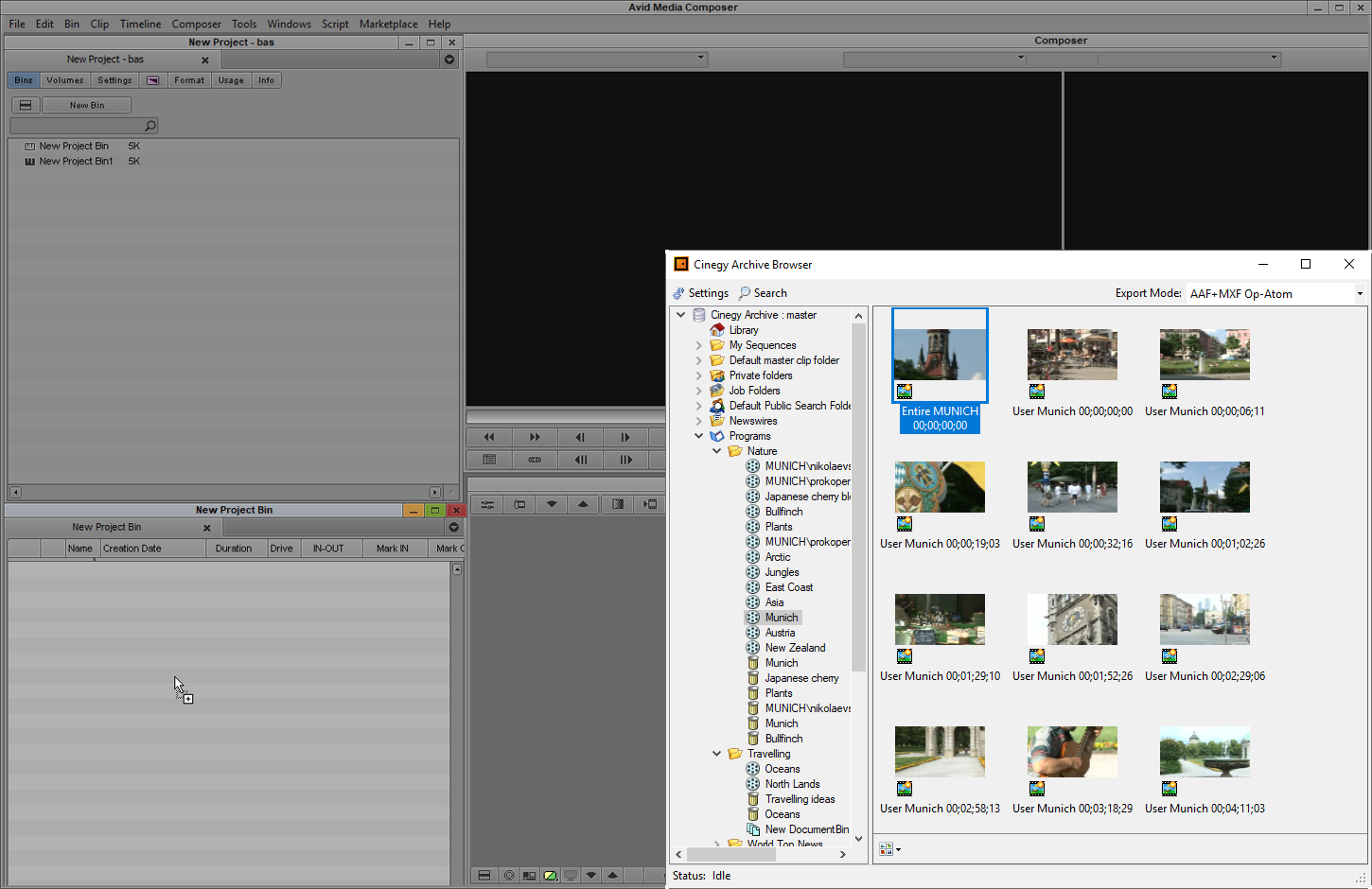
The following progress bar is shown during the exporting process:

To abort the process in progress, press "Cancel".
Media for all the objects being exported are converted into MXF files and the references for generated MXFs are written into a created AAF file.
|
Note
|
Make sure that the "MXF media location" is set up correctly in the Cinegy Archive Browser options dialog; otherwise the Avid Media Composer will not find the generated MXF files and you will get the "Media offline" message. |
|
Important
|
Refer to the AAF + MXF Op-Atom Settings paragraph within the Export Modes article for details on "MXF media location" configuration. |
The following table shows the feature mapping when a Sequence is imported to Avid Media Composer:
| Feature | Status | Description | ||
|---|---|---|---|---|
Video clips |
Fully supported |
Video clips will be transferred with no changes. |
||
Audio clips |
Fully supported |
Audio clips will be transferred with no changes. |
||
Flop |
Fully supported |
The corresponding flop effect will be applied in the Avid sequence. |
||
Dissolve |
Fully supported |
The corresponding dissolve mix will be applied in the Avid sequence. |
||
SMPTE mixes |
Coming soon |
The feature is ignored during export. |
||
Dip to color |
Coming soon |
The feature is ignored during export. |
||
Speed |
Fully supported |
The corresponding speed effect will be applied in the Avid sequence. |
||
Freeze |
Special |
The corresponding freeze effect will be applied in the Avid sequence for video clips. Audio clips will be replaced with fillers of the corresponding duration. |
||
Titler |
Special |
Media is exported without the alpha channel information (blended on the black background) or is replaced with fillers.
|
||
Pictures |
Special |
Media is exported without the alpha channel information (blended on the black background) or is replaced with fillers.
|
||
Audio pan balance |
Coming soon |
The feature is ignored during export. |
||
Video transparency key frames |
Coming soon |
The feature is ignored during export. |
||
Multiclip |
Coming soon |
The multiclip is replaced with a filler of the corresponding duration. |
||
Color correction |
Not supported yet due to technical limitations |
The feature is ignored during export. |
||
Inverse effect |
Not supported yet due to technical limitations |
The feature is ignored during export. |
When the import is done, the items are ready to be used in Avid Media Composer:
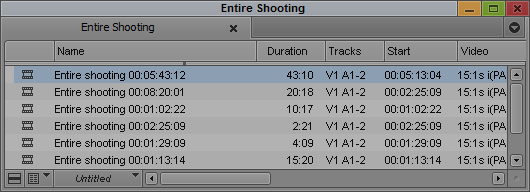
Export From Avid Media Composer to Cinegy Archive Using Drop Target Window
There is a special "drop target" window that supports the dragged-and-dropped items from Avid Media Composer Bins – AAF files. It can be launched via the "Show drop target window" command:
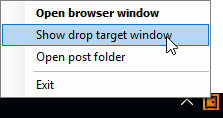
The following "Drop to Cinegy Archive" window appears:
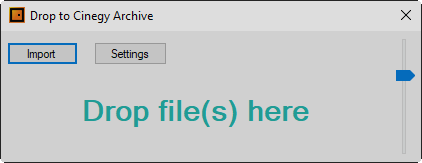
The "Drop to Cinegy Archive" window always stays on top; you can change its transparency using the slider on the right side of the window.
|
Press the "Import" button to launch the standard "Open" dialog and select the file(s) for import. |
Alternatively, you can drag-and-drop clips or compositions from the Avid Media Composer workspace into the "Drop to Cinegy Archive" window. The other way is to select the previously created AAF file(s) and drag-and-drop them into this window.
|
Note
|
The import is impossible unless the target location is defined in the "Target folder in Cinegy Archive DB" field on the "Main Settings" window. |
|
Note
|
Only AAF file format is supported for import into Cinegy Archive. |
As soon as the files are added, the import session starts automatically. The window caption displays the import process details:
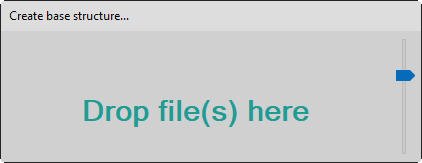
The "Select node" dialog box will appear allowing you to define the target Cinegy Archive database location for importing media:
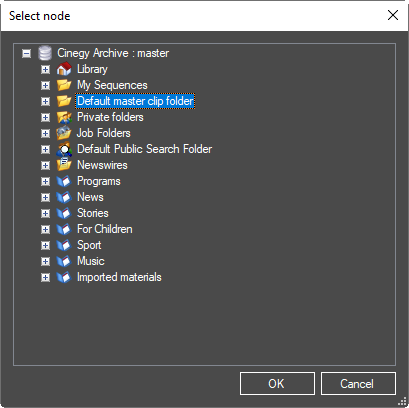
The following window informs whether the import process is finished successfully or failed and displays the detailed information about the performed operations:
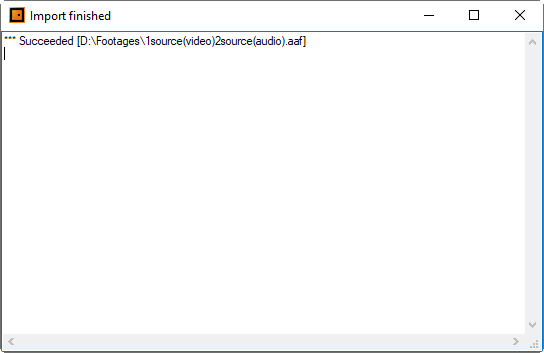
Settings
For successful import operations, the required settings should be properly configured.
|
Press the "Settings" button and specify the settings in the following dialog that appears: |
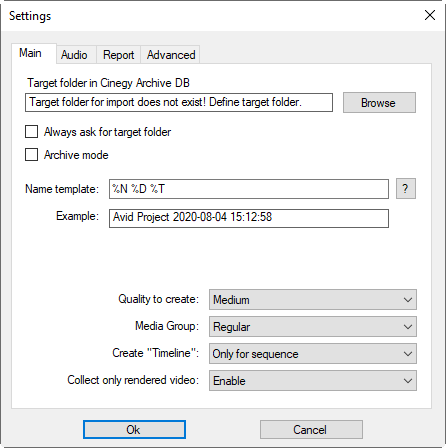
The groups of settings are split into separate tabs.
Main Settings
Define the following parameters on the "Main" tab:
-
Target folder in Cinegy Archive DB – defines the target folder within the Cinegy Archive database where the imported media files will be placed.
-
Always ask for target – if selected, the window with the database tree will be opened to select the target folder within the Cinegy Archive database, each time the new import operation is initiated.
-
Archive mode – if selected, the DocumentBin containing *.aaf and *.aaf.archive files will be created while importing media files, which can be used to restore exported media in Avid Media Composer.
-
Name template – defines a file name macro to automate the imported media naming. The file name preview is displayed in the "Example" field.
-
Quality to create – the clips being exported from Avid Media Composer to Cinegy Archive database will be assigned with the high or medium quality, chosen from the drop-down list.
-
Media Group – defines the media group that will be assigned for the created Roll.
-
Create "Timeline" – defines whether the sequence will be created.
-
Collect only rendered video – if selected, only rendered video with applied in Avid Media Composer changes will be exported, without its original video file.
Audio Settings
The imported media can contain up to 16 audio tracks. Deselect the checkboxes next to audio track(s) that should not be imported from Avid Media Composers project:
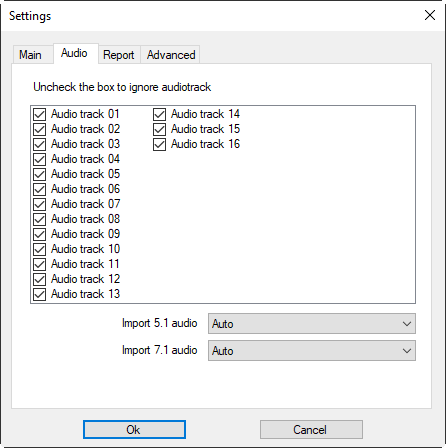
-
Import 5.1 audio – defines the path order for the 5.1 audio import.
-
Import 7.1 audio – defines the path order for the 7.1 audio import.
Report Settings
The following tab contains settings for report generation:
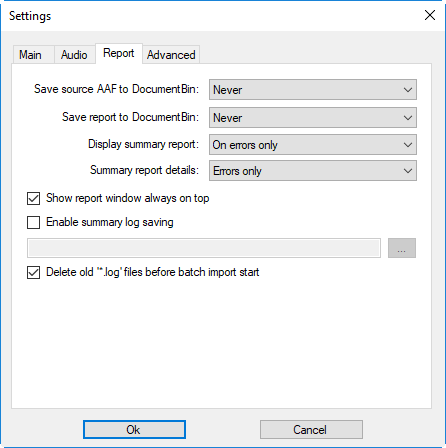
-
Save source AAF to DocumentBin – defines when the source *.aaf file will be saved to the DocumentBin while importing media files: always, on errors only and never.
-
Save report to DocumentBin – defines when the report *aaf.log file will be saved to the DocumentBin: always, on errors only and never.
-
Display summary report – defines when the report *.log file will be automatically open on the import operation end: always, on errors only and never.
-
Summary report details – defines the type of the summary written in the *.log report file: full or on errors only.
-
Show report window always on top – if selected, the report *.log window will be displayed on top of all currently open windows after importing media files.
-
Enable save summary log – if selected, the save summary *.log file to the defined folder is enabled.
-
Delete old '*.log' files before start batch import – if selected, the previous *.log files will be deleted and the latest one created before initializing the batch import session.
Advanced Settings
The following tab contains advanced settings for Avid media composer integration:
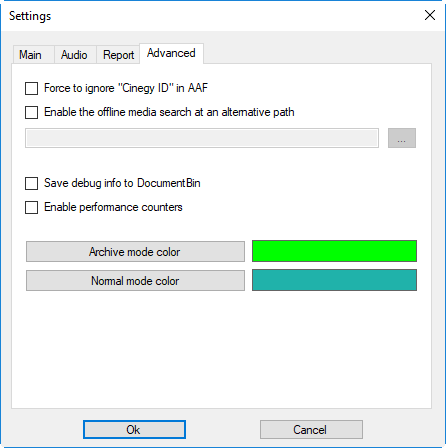
-
Force to ignore "Cinegy ID" in AAF – if selected, links to the existing files in the database will be created. If not selected, new files will be created, containing one of the following Cinegy Archive objects: clip, master clip, ClipBin, Sequence, Roll, etc.
-
Enable the offline media search at an alternative path – if selected, the offline media search at the alternative defined folder is enabled, in case the media was transferred.
-
Save debug info to DocumentBin – if selected, the *.dump file will be saved to the DocumentBin.
-
Enable performance counters – if selected, the performance statistics will be added to the report file.
-
Archive mode color – press the button to define the text color within the "Drop to Cinegy Archive" window in the Archive mode and choose the color from the basic colors set.
-
Normal mode color – press the button to define the text color within the "Drop to Cinegy Archive" window and choose the color from the basic colors set.
Sample Workflow
Cinegy Archive Browser allows to export proxy quality and then relink it with high quality. The following workflow represents the "push model" when the operator manually selects the Cinegy Archive object to be sent to Avid Media Composer. The steps below show the sample workflow for rough-editing of the proxy quality files in Avid Media Composer and then relinking them to the high resolution files:
-
Configure Cinegy Archive Browser:
-
set "Export mode" to "AAF+MXF Op-Atom":
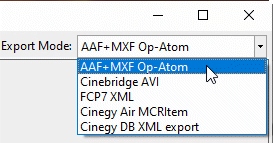
-
in Cinegy Archive Browser "AAF+MXF Op-Atom Settings" window, select the proxy quality from the drop-down list (Avid 15:1s) and deselect the "Do not recompress if source format can be used in Avid directly" option:
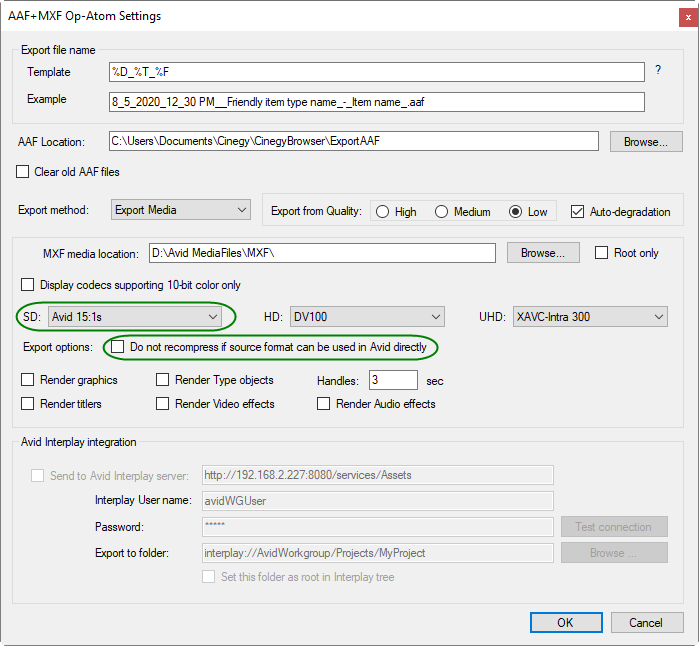
-
-
Drag-and-drop the specified objects from Cinegy Archive Browser into Avid Media Composer bin.
-
Perform the desired editing operations in Avid Media Composer using these proxy quality media.
-
In Cinegy Archive Browser "AAF+MXF Op-Atom Settings" window, change the media files format settings to the desired high quality.
-
Select the same Sequence in the explorer tree and drag-and-drop the specified objects from Cinegy Archive Browser into Avid Media Composer bin again.
-
When the export is completed, the new MXF files will be generated according to the specified settings. Now the object contains media of high and low quality.
-
Finalize your composition in Avid Media Composer using high quality media. Link high-resolution files to files with proxy quality to keep the media at its original resolution.
Avid Interplay Integration
|
Note
|
To activate Avid Interplay integration functionality, please contact your Cinegy sales representative. |
When all the necessary Avid export parameters are set up, the Avid Interplay folders tree panel will appear:
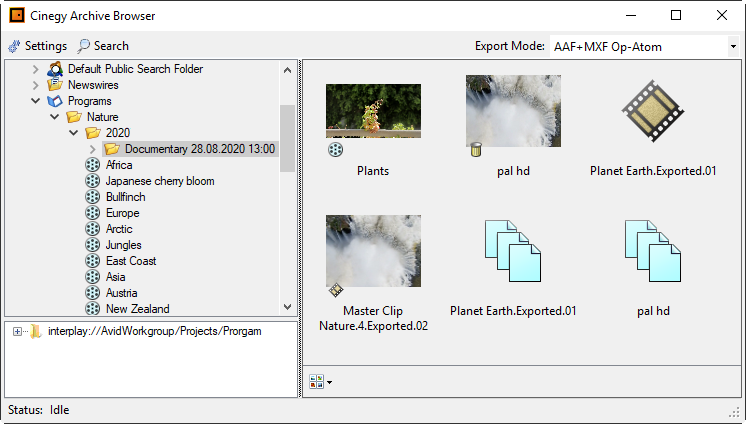
To send the object to the Avid Interplay server, select the object and drag and drop it to the desired folder in the Interplay tree:
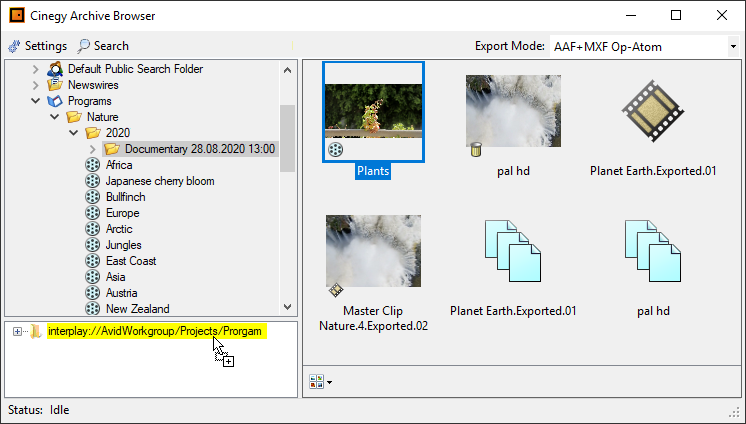
Alternatively, select the "Send to Avid Interplay" command from the object’s context menu.
|
Note
|
Make sure that the "MXF media location" is set up correctly in the Cinegy Archive Browser options dialog; otherwise, Avid Media Composer will not find the generated MXF files and you will receive "Media offline" messages. |
The following window will inform you of the exporting progress:

The files will be exported to the specified Avid media files folder.
Working with Post Folder
Post folder is a special network shared folder which checks for the appearance of new AAF files to be imported into the Avid Media Composer projects.
When a new AAF file is added, a message appears above the notification area of the task bar, informing you about the new file:
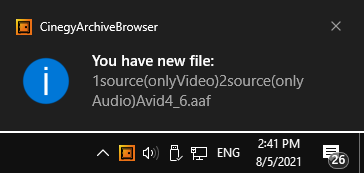
The content of the post folder can be managed via the "Post" manager. To open it, right-click the Cinegy Archive Browser icon and choose the "Open post folder" command:
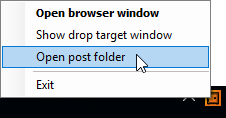
The following "Post" manager appears:
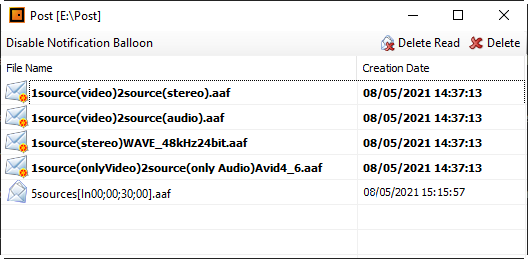
Here the list of AAF files (so-called "posts") contained in the post folder is displayed.
|
Those posts that have not been imported to Avid Media Composer are marked as unread. |
|
The posts that have been imported to Avid Media Composer are marked as read. |
To import a post to Avid Media Composer, select the required one and drag-and-drop it to an Avid Media Composer project.
|
Press the "Delete" button to delete the selected post(s) from the post folder. |
|
Press the "Delete Read" button to delete all the read posts from the post folder. |
|
To disable notification balloon, click the corresponding text box. When disabled, it has a blue border. |






